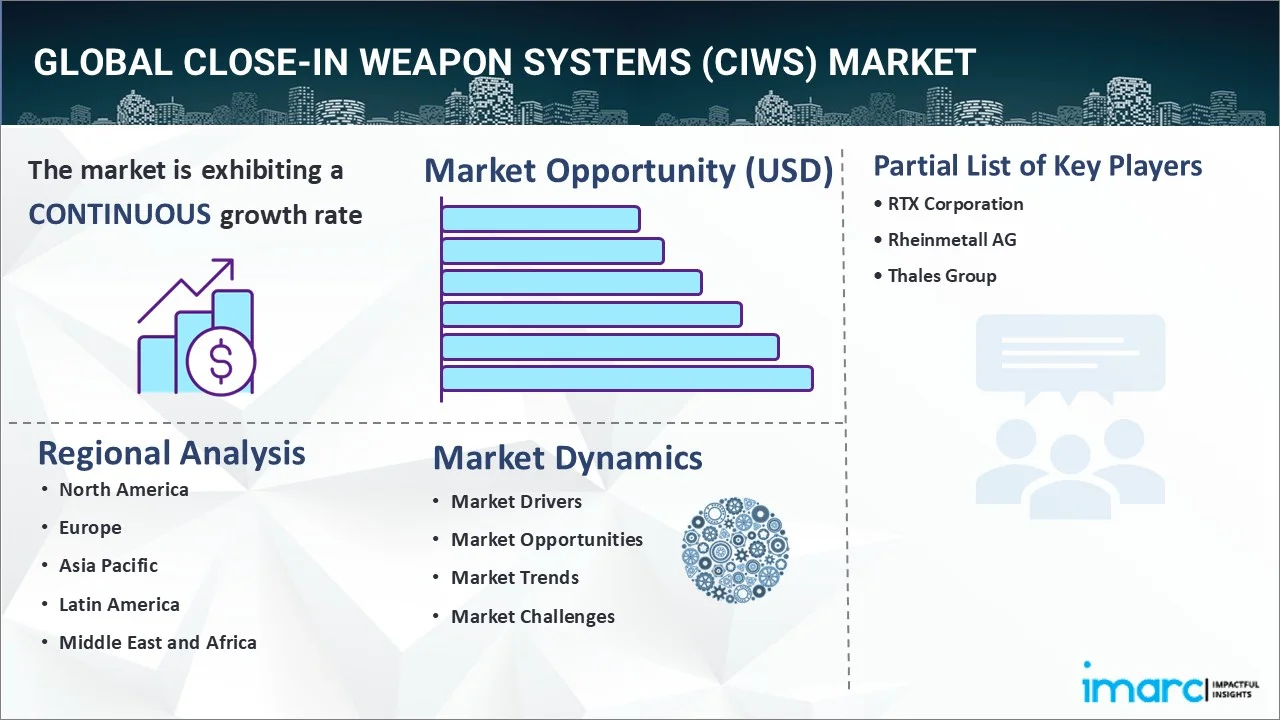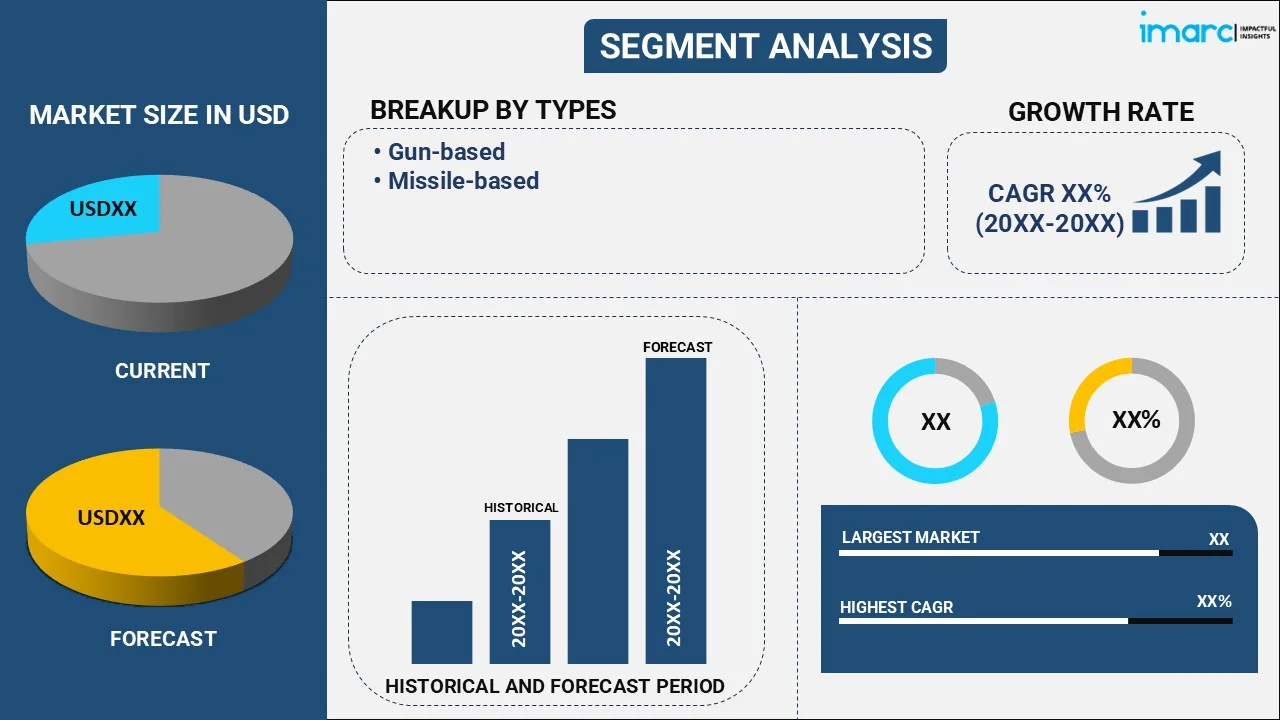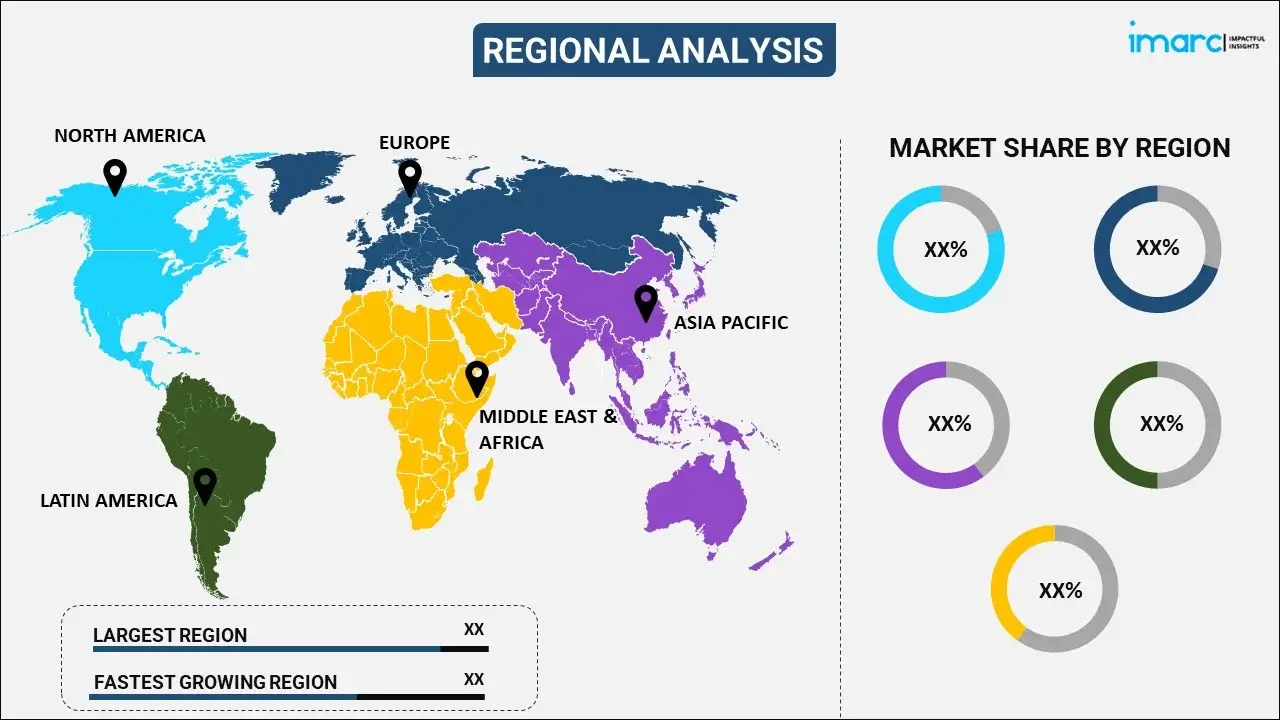
Close-In Weapon Systems (CIWS) Market Report by Type (Gun-based, Missile-based), Platform (Terrestrial, Navy), and Region 2025-2033
Market Overview:
The global close-in weapon systems (CIWS) market size reached USD 7.5 Billion in 2024. Looking forward, IMARC Group expects the market to reach USD 17.7 Billion by 2033, exhibiting a growth rate (CAGR) of 9.07% during 2025-2033. Rising maritime threats, surging demand for improved naval defense technologies, technological advancements in radar and weapon control systems, increasing naval modernization programs worldwide, the growing focus on autonomous systems integration, and the affordability of system upgrades are some of the key factors fueling the market growth.
|
Report Attribute
|
Key Statistics |
|---|---|
|
Base Year
|
2024 |
|
Forecast Years
|
2025-2033
|
|
Historical Years
|
2019-2024
|
| Market Size in 2024 | USD 7.5 Billion |
| Market Forecast in 2033 | USD 17.7 Billion |
| Market Growth Rate (2025-2033) | 9.07% |
Close-in weapon systems (CIWS) are defense mechanisms primarily used by naval forces to detect and combat short-range threats, such as missiles and aircraft. It automatically detects, tracks, and engages targets, providing a vital layer of protection for the vessel. The system also integrates the use of radar-guided gatling guns, missiles, or a combination of both. The key advantages of CIWS include its ability to respond rapidly to incoming threats, thus enhancing the survivability of the vessel. Furthermore, its automated nature allows for a more accurate response without significant manual intervention. Types of CIWS include gun-based systems, such as the Phalanx, and missile-based systems.

The increase in maritime threats emphasizes the need for advanced naval defense technologies, which represents one of the key factors augmenting the market growth. Moreover, technological advancements in radar and weapon control systems enable more efficient detection and neutralization of threats, further accelerating the market growth. In line with this, an upsurge in naval modernization programs across various nations is fostering the demand for CIWS, which is supporting the market growth. Additionally, the rising interest in integrating autonomous systems to enhance operations and the surging defense expenditure are acting as other growth-inducing factors. Apart from this, the increasing need to protect against low-level aerial and surface and upgrade existing systems are providing a considerable thrust to the market growth.
Close-In Weapon Systems (CIWS) Market Trends/Drivers:
Increase in maritime threats
With escalating tensions worldwide, maritime threats have seen a considerable increase, which underscores the need for advanced naval defense technologies, such as close-in weapon systems (CIWS). Threats include fast, low-flying missiles, unmanned aerial vehicles (UAVs), and small, high-speed surface crafts. In response to these evolving dangers, navies around the globe are seeking enhanced, responsive, and reliable CIWS to counteract potential threats efficiently. The immediacy and potentially devastating impact of such threats make it crucial for defense systems to be capable of swift and precise responses, which is considerably boosting the demand for CIWS.
Technological advancements in radar and weapon control systems
As technology progresses, so does the effectiveness of CIWS. Recent advancements in radar technologies have made CIWS more capable of detecting, tracking, and engaging threats with increased precision and speed. For instance, innovations in phased array radar technology have enhanced the system's ability to detect and track multiple targets simultaneously. Similarly, advancements in weapon control systems, including automation and machine learning technologies, have improved the system's reaction time and accuracy. These improvements significantly increase the system's ability to neutralize threats and protect naval vessels, thereby encouraging greater adoption of the technology and driving growth in the CIWS market.
Upsurge in naval modernization programs
Globally, nations are heavily investing in their naval forces, undertaking modernization programs to stay competitive and ensure maritime security. These initiatives typically involve upgrading existing defense systems or replacing outdated ones with more sophisticated solutions. As a part of these modernization efforts, countries are integrating advanced CIWS into their naval vessels to improve their defense capabilities. CIWS provide a last line of defense against incoming threats, and their role becomes even more critical as the complexity of potential threats increases. These modernization programs are thus fostering the demand for CIWS, propelling the growth of the global CIWS market.
Close-In Weapon Systems (CIWS) Industry Segmentation:
IMARC Group provides an analysis of the key trends in each segment of the global close-in weapon systems (CIWS) market report, along with forecasts at the global, regional, and country levels for 2025-2033. Our report has categorized the market based on type and platform.
Breakup by Type:

- Gun-based
- Missile-based
The report has provided a detailed breakup and analysis of the market based on the type. This includes gun-based and missile-based.
For gun-based CIWS segment, the primary driver is their proven efficacy in neutralizing a variety of threats, including high-speed and low-altitude aircraft, missiles, and surface threats. Their relatively lower cost and easy maintenance, combined with their high-speed response, make them an attractive choice for many defense forces. Conversely, missile-based CIWS offer a longer range and higher accuracy, making them particularly effective against sophisticated, fast-moving, and maneuverable threats. Their ability to engage multiple targets concurrently is a critical factor driving their adoption. Moreover, recent advancements in missile technologies, such as guided missile systems and the development of smaller, more efficient and powerful missiles, are also fueling growth in the missile-based market segment.
Breakup by Platform:
- Terrestrial
- Navy
Terrestrial dominates the market
The report has provided a detailed breakup and analysis of the market based on the platform. This includes terrestrial and navy. According to the report, terrestrial represented the largest segment.
In the terrestrial segment, one key driver is the increasing need for fortified land defenses due to escalating geopolitical tensions and border disputes. The threat of drone strikes and other low-flying attacks make CIWS essential for land-based defense structures. Enhanced technologies, such as high-speed gun systems, radar tracking, and electro-optical sensors, contribute to this need as they provide improved accuracy and target detection. Additionally, the rise in domestic manufacturing capabilities and government emphasis on self-reliance in defense equipment production is spurring growth in this segment. On the other hand, the navy segment is influenced by the rise in naval modernization programs and heightened maritime security concerns. As naval forces confront evolving threats, including fast, low-flying missiles and small, high-speed surface crafts, the demand for advanced naval defense technologies such as CIWS grows. Furthermore, compliance with international maritime security regulations and increased focus on autonomous systems for enhanced operational efficiency are also driving the adoption of CIWS in naval platforms.
Breakup by Region:

- North America
- United States
- Canada
- Europe
- Germany
- France
- United Kingdom
- Italy
- Spain
- Others
- Asia Pacific
- China
- Japan
- India
- South Korea
- Australia
- Indonesia
- Others
- Latin America
- Brazil
- Mexico
- Others
- Middle East and Africa
North America exhibits a clear dominance, accounting for the largest close-in weapon systems (CIWS) market share
The report has also provided a comprehensive analysis of all the major regional markets, which include North America (the United States and Canada); Europe (Germany, France, the United Kingdom, Italy, Spain, Russia, and others); Asia Pacific (China, Japan, India, South Korea, Australia, Indonesia, and others); Latin America (Brazil, Mexico, and others); and the Middle East and Africa. According to the report, North America accounted for the largest market share.
North America's substantial military investment, including the world's largest defense budget in the United States, promotes the growth of the CIWS market, with advanced CIWS integrated into navy vessels to counter escalating maritime threats. In Europe, collective defense efforts among NATO countries are bolstering the CIWS market, as nations modernize their naval capabilities. Major defense companies in Europe also contribute through consistent research and development, enhancing CIWS technology. In the Asia Pacific, naval modernization initiatives in countries like China, India, and South Korea stimulate the CIWS market, given maritime disputes and increasing security concerns. Latin America, with extensive coastlines and exclusive economic zones, is upgrading naval capabilities to secure maritime interests and comply with international maritime security norms, thus driving the CIWS market. The Middle East and Africa require advanced naval defense systems due to heightened tensions and conflicts among countries, thereby boosting demand for CIWS.
Competitive Landscape:
The competitive landscape of the global close-in weapon systems (CIWS) market is defined by a high level of technological sophistication and a constant drive for innovation. While it's crucial not to focus on specific players, it's pertinent to acknowledge that market participants range from established defense contractors to innovative startups. These entities are constantly pushing the envelope in terms of research and development to create more efficient, reliable, and advanced CIWS. Collaborations, partnerships, and contracts with governments form a significant part of the competitive dynamics. Geographical presence also plays a key role, as entities strive to establish and strengthen their footprints across various regions. It's also vital to mention the growing emphasis on domestic production capabilities, making self-reliance an increasingly important competitive parameter in this market.
The report has provided a comprehensive analysis of the competitive landscape in the market. Detailed profiles of all major companies have also been provided. Some of the key players in the market include:
- RTX Corporation
- Rheinmetall AG
- Thales Group
Close-In Weapon Systems (CIWS) Market Report Scope:
| Report Features | Details |
|---|---|
| Base Year of the Analysis | 2024 |
| Historical Period | 2019-2024 |
| Forecast Period | 2025-2033 |
| Units | Billion USD |
| Scope of the Report | Exploration of Historical and Forecast Trends, Industry Catalysts and Challenges, Segment-Wise Historical and Predictive Market Assessment:
|
| Types Covered | Gun-based, Missile-based |
| Platforms Covered | Terrestrial, Navy |
| Regions Covered | Asia Pacific, Europe, North America, Latin America, Middle East and Africa |
| Countries Covered | United States, Canada, Germany, France, United Kingdom, Italy, Spain, China, Japan, India, South Korea, Australia, Indonesia, Brazil, Mexico |
| Companies Covered | RTX Corporation, Rheinmetall AG, Thales Group, etc. |
| Customization Scope | 10% Free Customization |
| Post-Sale Analyst Support | 10-12 Weeks |
| Delivery Format | PDF and Excel through Email (We can also provide the editable version of the report in PPT/Word format on special request) |
Key Questions Answered in This Report:
- How has the global close-in weapon systems (CIWS) market performed so far, and how will it perform in the coming years?
- What are the drivers, restraints, and opportunities in the global close-in weapon systems (CIWS) market?
- What is the impact of each driver, restraint, and opportunity on the global close-in weapon systems (CIWS) market?
- What are the key regional markets?
- Which countries represent the most attractive close-in weapon systems (CIWS) market?
- What is the breakup of the market based on the type?
- Which is the most attractive type in the close-in weapon systems (CIWS) market?
- What is the breakup of the market based on the platform?
- Which is the most attractive platform in the close-in weapon systems (CIWS) market?
- What is the competitive structure of the global close-in weapon systems (CIWS) market?
- Who are the key players/companies in the global close-in weapon systems (CIWS) market?
Key Benefits for Stakeholders:
- IMARC’s report offers a comprehensive quantitative analysis of various market segments, historical and current market trends, market forecasts, and dynamics of the close-in weapon systems (CIWS) market from 2019-2033.
- The research study provides the latest information on the market drivers, challenges, and opportunities in the global close-in weapon systems (CIWS) market.
- The study maps the leading, as well as the fastest-growing, regional markets. It further enables stakeholders to identify the key country-level markets within each region.
- Porter's five forces analysis assist stakeholders in assessing the impact of new entrants, competitive rivalry, supplier power, buyer power, and the threat of substitution. It helps stakeholders to analyze the level of competition within the close-in weapon systems (CIWS) industry and its attractiveness.
- Competitive landscape allows stakeholders to understand their competitive environment and provides an insight into the current positions of key players in the market.
Need more help?
- Speak to our experienced analysts for insights on the current market scenarios.
- Include additional segments and countries to customize the report as per your requirement.
- Gain an unparalleled competitive advantage in your domain by understanding how to utilize the report and positively impacting your operations and revenue.
- For further assistance, please connect with our analysts.
 Inquire Before Buying
Inquire Before Buying
 Speak to an Analyst
Speak to an Analyst
 Request Brochure
Request Brochure
 Request Customization
Request Customization




.webp)




.webp)












